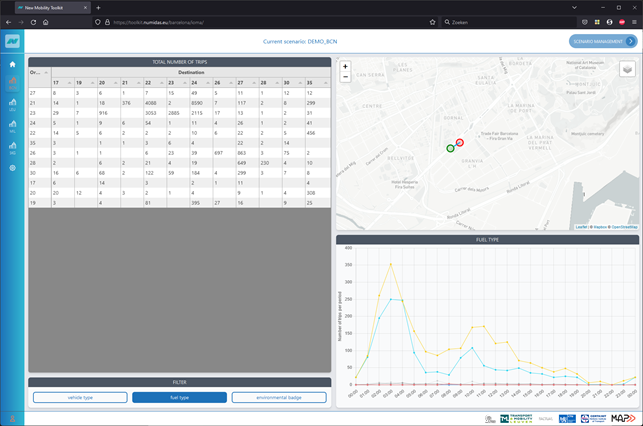nuMIDAS is finalising the development of its decision support system tooling before the end of 2022. The last few months of the project were aimed at the development and implementation of all selected use cases. It has been an intensive process, together with our partners and pilot cities, to work out the details of each tool and solve the challenges we encountered. In the last newsletter, we explained the first two use cases we were developing: “Pre-planning of shared mobility services” and “Planning for parking”. Since then, we have worked on some substantial improvements for these use cases, by adding new functionalities, more input control by the user, and optimising algorithms of the toolkit, to ensure quick calculation times for the users. In the last period, we have also developed the four other selected use cases concerning “Air quality and vehicle emissions”, “Operative area analysis of shared mobility services”, “Inflows and outflows of a metropolitan area” and “Assessment traffic management scenarios”. The figure above shows the landing page of the toolkit with an overview of the cities and use cases.
The nuMIDAS team also paid attention to the user-friendliness of the dashboard, organising usability test sessions with end-users from our pilot cities to learn more about how the user interacts with the dashboard. Based on these sessions, the dashboard underwent considerable design changes since the first concepts. As a result, we have developed a dashboard that includes 6 different tools that can help policymakers with the mobility challenges faced by their cities or regions. The figure bellow gives an impression of the toolkit interface. This is the presentation of the inflows and outflows of the ANPR camera system of the city of Barcelona.
During this second stage of the toolkit development, a generic configuration approach for use cases was implemented using standard naming conventions for use cases, data tables, and storage. This approach is accompanied by a JSON configuration describing the presentation layer layout, inputs, and outputs. Additionally, the user management was extended to cope with different access levels based on city management and end-user usage. This approach has had a direct impact on the timely implementation of the last series of use cases because standard configurations were already available and a lot of code could be reused. Looking into the future, we are determined to continue with nuMIDAS as a service for policymakers all over Europe. A cooperation model has been developed with the consortium that allows partners and cities to collaborate and provide the nuMIDAS toolkit. Are you curious about what nuMIDAS can do for your city? Feel free to contact us through our website with your questions so that we can get in touch. And do follow us on our channels to stay up to date with all the developments that will be coming your way!






